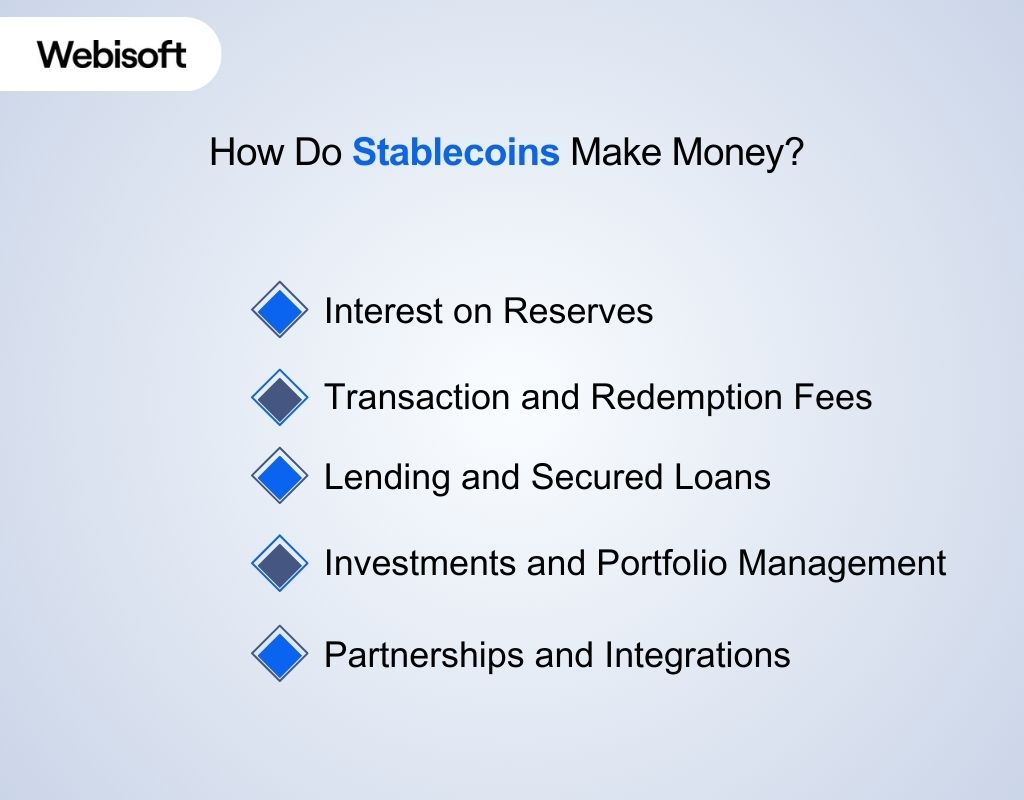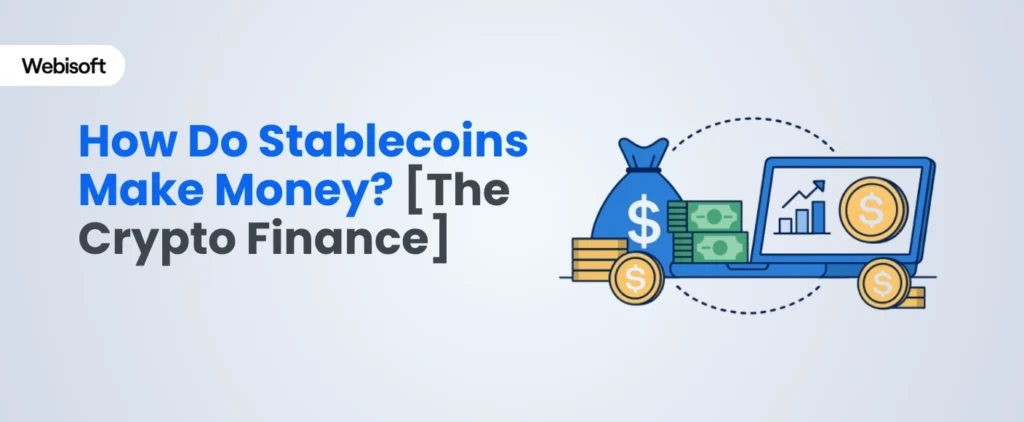Stablecoins might seem simple on the surface, but they’re digital currencies that stay at a fixed value, usually pegged to the U.S. dollar. But have you ever wondered if they don’t rise in price like Bitcoin, what keeps them profitable?
So, how do stablecoins make money?
Stablecoin issuers generate revenue through interest on reserves, transaction fees, lending, and partnerships with financial institutions. They invest reserves in U.S. Treasury bills, bank deposits, and other assets to earn yield. Some also charge fees for conversions.
But there’s more to it than just that. We’ll break down the exact ways stablecoins generate profits, compare different stablecoin models, and give insight into the future of stablecoin monetization.
Contents
How Do Stablecoins Make Money?

Stablecoin issuers operate like financial institutions, generating revenue through several key income streams. Here’s how stablecoin issuers make money:
1. Interest on Reserves
Fiat-backed stablecoins, such as Tether (USDT) and USD Coin (USDC), are backed by real-world assets like cash, bank deposits, and U.S. Treasury bills. Instead of keeping these reserves idle, issuers invest them in interest-bearing instruments, such as:
- Short-term U.S. Treasuries (low-risk government bonds)
- Money market funds
- Bank deposits with yield
The interest generated on these reserves is the primary revenue source for most stablecoin issuers.
For example, Tether reported earning $5.2 billion in interest profits in 2024. This credit should be given to rising U.S. Treasury yields. Circle (USDC’s issuer) saw profits surge when interest rates climbed, earning approximately $2.1 billion in 2023.
2. Transaction and Redemption Fees
These fees discourage excessive transactions while providing a steady income stream for issuers. These fees discourage excessive transactions while providing a steady income stream for issuers.
3. Lending and Secured Loans
Another way to profit from stablecoins is by lending and securing loans. Some stablecoin issuers engage in lending activities, where they loan out a portion of their reserves to institutions, earning interest.
In the past, Tether issued secured loans using reserve funds, earning higher yields than Treasury bills. However, regulatory scrutiny led them to phase out this practice.
On the Decentralized Finance (DeFi) side, stablecoin protocols DAO issue loans backed by crypto collateral. Users deposit assets (e.g., ETH) and borrow stablecoins against their holdings, paying an interest fee, which becomes revenue for the system.
4. Investments and Portfolio Management
Stablecoin issuers invest their reserves to increase returns. While low-risk U.S. Treasuries make up the majority of these holdings, some have previously allocated funds to commercial paper, corporate bonds, and even crypto assets.
For example, MakerDAO shifted part of its DAI collateral into U.S. bonds, earning a yield while maintaining decentralization.
Though investing reserves can increase profits, it also introduces risks—especially if issuers take on speculative positions.
5. Partnerships and Integrations
Stablecoin issuers collaborate with banks, fintech firms, and payment processors to expand adoption.
- Circle partnered with Visa to facilitate cross-border payments using USDC.
- Coinbase earns a revenue share from USDC holdings, making it profitable to promote stablecoins.
Additionally, stablecoins like PayPal’s PYLUSD are directly integrated into financial ecosystems, generating transaction fees for their parent companies.
How Can Users Make Money With Stablecoins?

Stablecoins offer profit opportunities. Investors and traders use them to generate passive income and take advantage of market inefficiencies. It’s not like you’ll just create a stablecoin and start earning easily. Let’s learn how stablecoins make a profit for their users:
1. Earning Interest Through Lending
Users can deposit stablecoins into:
- DeFi lending platforms like Aave, Compound, and MakerDAO earn APY on loans.
- Centralized exchanges (CeFi), such as Finance or Coinbase, which offer interest-bearing stablecoin accounts.
During bull markets, stablecoin lending rates can reach 8–10% APY. However, users must assess platform risks (e.g., hacks, insolvencies).
2. Liquidity Provision in DeFi
Stablecoins are widely used in decentralized exchanges (DEXs) for liquidity pools. By providing liquidity, users earn:
- Trading fees (e.g., Uniswap pools pay a 0.3% cut per transaction).
- Liquidity mining rewards (e.g., Curve Finance incentives for stablecoin pools).
Stablecoin liquidity providers benefit from low price volatility, making this a safer DeFi income strategy.
3. Arbitrage Trading
Because stablecoins occasionally trade above or below $1, traders can profit from price differences:
- Exchange arbitrage: Buying USDT at $0.998 on one exchange and selling it at $1.002 elsewhere.
- Peg deviation arbitrage: When USDC fell to $0.88 in March 2023, traders who bought at a discount profited when it rebounded.
Sophisticated traders and bots often execute these strategies within seconds.
Comparing Stablecoin Models: How They Differ?
Not all stablecoins operate under the same model. The strategies to earn from stablecoins vary depending on the type of stablecoin:
| Stablecoin Type | Backing Mechanism | Revenue Streams | Examples |
| Fiat-Backed (Centralized) | Fully backed by cash, bank deposits, and Treasuries | Interest on reserves, transaction fees, partnerships | USDT, USDC, PYUSD |
| Crypto-Backed (Decentralized) | Backed by over-collateralized crypto (ETH, BTC, etc.) | Stability fees (loan interest), liquidation fees | DAI (MakerDAO), LUSD |
| Algorithmic | Peg maintained by supply adjustments or arbitrage incentives | Seigniorage (minting profit), trading fees | FRAX, Ampleforth |
Fiat-backed stablecoins remain the most profitable, while crypto-backed models distribute revenue within DeFi ecosystems. Algorithmic stablecoins have struggled to sustain profitability in the long term.
Challenges and Future Trends in Stablecoin Monetization

Now that you know how to make money from stable coins, it’s also necessary to understand the future challenges for stablecoin monetization. Such as:
1. Regulatory Scrutiny
Stablecoins have drawn significant attention from global regulators, with governments pushing for stricter reserve requirements, compliance rules, and transaction limits.
These measures aim to increase transparency and reduce financial risks, but they also impact profitability for stablecoin issuers.
One of the most notable examples is New York’s crackdown on Binance USD (BUSD). In early 2023, regulators forced Paxos, the issuer of BUSD, to stop minting new tokens, citing concerns about compliance and consumer protection.
This caused BUSD’s market cap to drop from $16 billion to under $5 billion in months, demonstrating the regulatory risks stablecoins face.
Future regulations could introduce:
- Stricter reserve management rules, limit how issuers invest their funds.
- Capital requirements, similar to banks, reduce profitability from interest earnings.
- Mandatory licensing for stablecoin issuers increases compliance costs.
The EU’s MiCA (Markets in Crypto-Assets Regulation) already imposes strict reserve and disclosure rules, which could become a global standard. Stablecoin issuers must adapt to these regulations while maintaining revenue growth.
2. Interest Rate Dependency
A key factor affecting how stablecoins make money is the prevailing interest rate environment. Since issuers profit primarily from interest on reserves, their revenue is closely tied to Federal Reserve policies and global monetary trends.
When the Federal Reserve raises interest rates, stablecoin issuers benefit. Tether (USDT) and Circle (USDC) earned record profits in 2023 and 2024 as U.S. Treasury yields surged.
However, the opposite is also true—if rates fall, revenue drops. Impact of interest rate cuts on stablecoin issuers:
- A 1% reduction in U.S. Treasury yields could reduce industry-wide stablecoin profits by over $1.5 billion per year.
- Lower interest rates may force issuers to increase transaction fees or seek alternative revenue streams.
- DeFi lending platforms offering yield on stablecoins may see reduced APYs, discouraging user deposits.
Stablecoin issuers must prepare for rate fluctuations by diversifying revenue beyond just interest earnings.
3. Future Trends in Stablecoin Monetization
As the stablecoin industry matures, issuers are exploring new ways to generate revenue while adapting to regulatory and market changes. Several emerging trends will shape how stablecoins make money in the coming years.
Yield-Bearing Stablecoins
To remain competitive, stablecoin issuers are considering sharing interest income with users. Traditionally, issuers keep 100% of reserve profits, but new models may allow holders to earn yield directly from stablecoins. For example:
- MakerDAO’s DAI Savings Rate (DSR) lets users lock DAI stablecoins to earn passive income.
- Future versions of USDC or USDT could introduce yield-bearing options, giving users a portion of reserve profits.
This shift could incentivize long-term holding of stablecoins, expanding adoption while creating a new revenue model for issuers.
Expansion into Non-USD Stablecoins
Currently, most stablecoins are pegged to the U.S. dollar, but demand for multi-currency stablecoins is rising.
- Circle launched Euro Coin (EURC), a euro-backed stablecoin, to expand beyond USD markets.
- Gold-backed stablecoins like Tether Gold (XAUt) offer an alternative for investors seeking asset-backed stability.
- More stablecoins could emerge for currencies like GBP, JPY, and emerging market currencies, diversifying revenue streams for issuers.
As global adoption grows, non-USD stablecoins may become a key profit driver, especially in regions with volatile fiat currencies.
Deeper Integration with Global Payments and Fintech
Stablecoins are increasingly being integrated into mainstream financial systems, creating new monetization opportunities.
- Visa and Mastercard have piloted stablecoin settlements, reducing reliance on traditional banking rails.
- PayPal’s PYUSD is directly embedded into PayPal’s payments network, earning transaction fees on every transfer.
- Fintech firms are exploring stablecoin-based payroll and remittance services, generating revenue from payment processing fees.
As banks, payment providers, and businesses integrate stablecoins, issuers could earn more through service fees, partnerships, and institutional adoption.
Conclusion
Stablecoins make money through interest on reserves, transaction fees, lending, and partnerships. Their profit model works in a way similar to that of traditional banks.
For you as a user, stablecoins provide stable and profitable opportunities in DeFi, trading, and lending. As they gain a bigger role in global finance, their revenue methods will keep evolving.
If you want to understand how stablecoins generate profits or how to benefit from them, Webisoft can help. Their experts can guide you through the process and find the best solutions for your needs.
FAQs
Here are some commonly asked questions by beginners and professionals regarding how do stablecoins make money:
1. Can users earn money with stablecoins like issuers?
Yes, users can earn money by lending stablecoins on DeFi platforms, staking for rewards, providing liquidity on DEXs, and engaging in arbitrage trading.
2. Why do stablecoins earn interest on reserves?
Fiat-backed stablecoins hold reserves in U.S. Treasuries and bank deposits, earning interest. Higher interest rates increase issuer profits significantly.
3. Do stablecoins charge fees for transactions or redemptions?
Yes, many stablecoins charge fees for minting, redeeming, and large-scale conversions. Tether, for example, has a 0.1% redemption fee for direct USDT withdrawals.
4. Are stablecoin profits affected by regulations?
Yes, regulations may limit reserve investments, require stricter compliance, or cap transaction fees, impacting stablecoin issuer profitability and business models.
